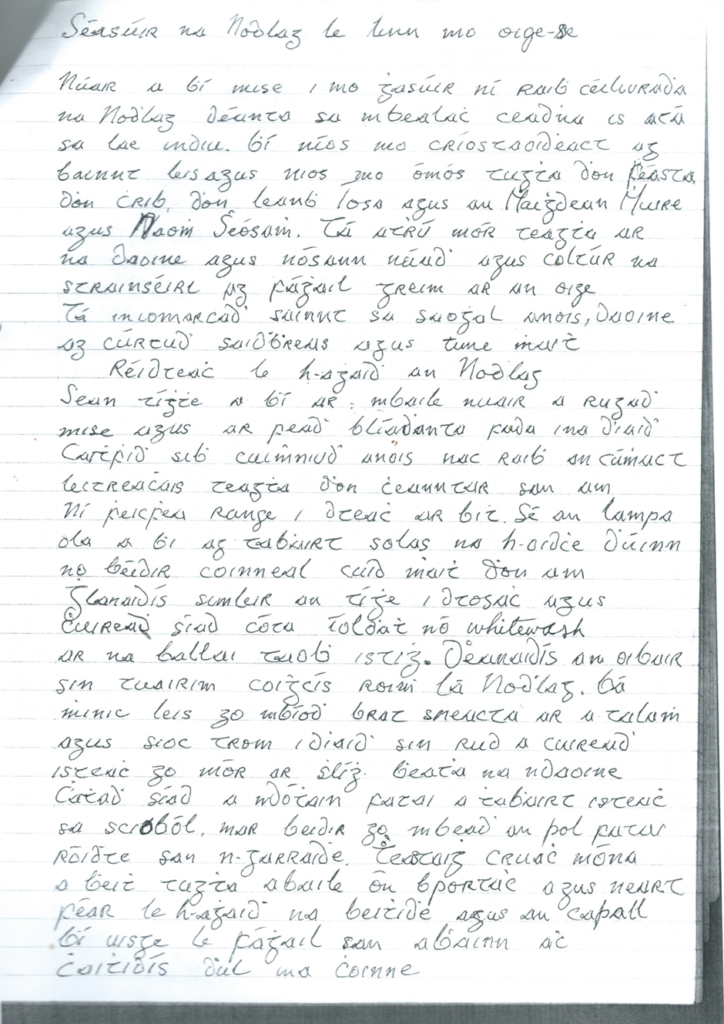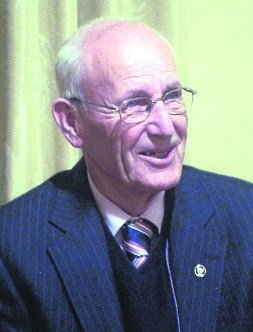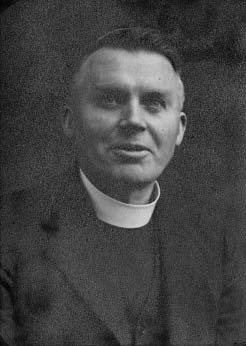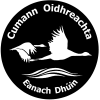
John Murphy or Seán Ó Murchú is a native Irish speaker from the parish of Annaghdown. In Addergoole village where he was raised there were many people who spoke mainly Irish, including his mother and uncle, and his father also learned to speak Irish. The Irish on this recording is the version of the language spoken in this area. John’s writing is in the old Irish script, an Cló Gaelach, and his spelling is the pre-standardised form. The notes were written by John in the late 1970s or early 1980s. This video was recorded on 22 July and 8 August 2022. Included below is an account 'Séasúir na Nodlag le Linn mo Oige-se' (the Christmas season in my youth), written by John in the old style Cló Gaelach script. Read more

Between 1720 and 1925, many local loan associations operated throughout Ireland, offering small loans to the 'industrious poor', for purposes such as buying grain, farm animals, or machinery. A scheme on the Kirwan estate at Castlehacket operated from the 1830s to the 1850s, which resulted in an excellent set of surviving records. A return of the state of the scheme in December 1853 is particularly interesting. It offers an insight into local conditions before and during the Famine, and records several inhabitants of the townlands of Bunatober, Cahermorris, Cluidrevagh, and Biggera, who died or emigrated during this period, as well as recording the progress of each person who took out a loan. Read more

Delia Green was born Delia Newell at Balrobuck, Corrandulla, in the Parish of Annaghdown, on the 5th of February 1915. She was born at a time of great turmoil both nationally and internationally. The Great War (World War 1) was being fought out in Europe, while at home Ireland was trying to gain freedom from its colonial master Britain.
Delia's father Tim was a blacksmith and the forge where he worked had been in the family for a number of generations. Her mother Mary was Mary Forde from near the present Corrandulla Barracks on the road into Corrandulla village. Delia was one of seven children. Mark, John, Michael, Delia, Nellie, Sonny and May. Read more

I asked Charlie about his early years and learned that he has no hang-ups about revealing his age.
I was born on the 8th of October 1921 and the name I got in baptism was Charles. I hadn't a second name, but wasn't I lucky enough to have one name? The name I took at confirmation was Joseph, because I was confirmed on St. Joseph's Day. My early life was in Kilgill, that would be about 700/800 yards from where I live now. That is where I was born. I had a brother older than me: John P. He is dead and a brother and sister younger than me. Read more

I came to Gort Roe in 1971, with my wife Margaretta D'Arcy and our four young sons. We had been living on an island in Loch Corrib, but because of the difficulty of getting the boys to school, we decided to move to the mainland during term-time. Margaretta went into Collerans, the estate agent, saying how much she was prepared to pay for a small house outside Galway that would be near a bus stop and near a shop. "Why, we have just the thing!" We could walk right into it that very day. Danny Griffin, shopkeeper in Wood Quay, had bought the house from the Cahills whose farmhouse it had been until they built a new bungalow next door. Mrs Griffin unfortunately had become ill so their dream of retirement into a cottage in the country was dashed. Read more

In Griffith's Valuation for the townland of Tomnahulla (mid 1850s), Cornelius Lundie is shown as the occupier of 617 acres, 2 roods, and 1 perch. He was born in the Manse, Kelso, Scotland on 29 May 1815, the eldest son of Rev. Robert Lundie (Parish Minister) and Mary Grey. He was educated privately and at the age of 14 years was apprenticed to an engineer. He attended classes in physical and mathematical science at both Glasgow and Edinburgh universities during several winter sessions while working during the summers in the shops of a country millwright at Kelso. In 1832 his father died and he secured employment with Charles Atherton at the works of the Broomielaw Bridge over the river Clyde from the designs of Thomas Telford. In 1836 he took charge of the Clarence Railway, part of the North-Eastern railway system in Durham where he remained for three years. He married Elizabeth Mould from Merrington, Durham on 9 April 1839. Read more

There isn't any chestnut tree spreading over the 'smithy' at the end of our village, as in that poem we learned at school; but ivy, clawing its way over the walls and on to the roof, and a swath of brambles spreading across the two small shuttered windows. And children on their way home from school do not look in at the open door; for not only do they now pass swiftly by in the luxury of bus and car, the sparks do not fly off the anvil anymore, as the forge now lies derelict and obsolete, having long ceased to be of use, the blacksmith's craft made redundant by the onset of high-powered farming and automation, and no work-horses in need of shoeing... Read more

The 2003 edition of 'Anach Cuain' described the 24 July centenary celebrations of the Church of St Brendan by the Lake at Annaghdown. The centrepeice was the visit of Most Rev. Michael Courtney, Titular Archbishop of Eanach Dúin and Apostolic Nuncio in Burundi who made the occasion a glittering event in the history of the Christian community of Annaghdown.
A deep bond instantaneously established itself between Archbishop Courtney and the people of his titular see, such was the personality and the manifest goodness of the man. His striking address will never be forgotten by those who were priveleged to be present to hear it. He himself felt so much at home that he expressed a firm intention to return in July 2004 to meet the people again and to accompany some of them on the annual Cruach Phádraig pilgrimage. Read more

Below are three photos from the Boys' National School in Corrandulla, taken during the 1930s and 40s. Sincere thanks to John Murphy, Cregduff, for these photos. Read more

Evelyn Stevens talks to Dutch thatcher Marika Leen about the art of thatching and how she came to learn the trade. Filmed in Cloonboo, Annaghdown, Co. Galway in summer 2020, at the thatched cottage of Pete Smith and Evelyn Stevens. An initiative of the Annaghdown Heritage Society. Labhraíonn Evelyn Stevens leis an tuídóir Ollainnis, Marika Leen, faoi chéird na tuíodóireachta agus an bealach a d'fhoghlaim sí an céird. Taifeadta i gCluain Bú, Eanach Dhúin, Co. na Gaillimhe, i samhradh 2020, ag teach ceann tuí Pete Smith agus Evelyn Stevens. Tionscnamh de chuid Cumann Oidhreachta Eanach Dhúin. Read more

Máirtín Moylan was born on the 10th of November 1898 to Thomas and Honor Moylan, (née Burke from Ardgaineen) of Farmerstown. His father died in January 1899 leaving his mother to rear the family by herself. Could it be from here, looking at his mother's strong will and determination that Máirtín found the resilience to see his cause through to the end in his later life? Honor may have needed time to get herself on her feet after her husband's death, and on the 31st of March 1901, Máirtín is to be found in the census records listed in the house of his grandparents, Michael and Ellen Burke (née Boyle from Carrowbrowne) of Ardgaineen. How long he remained with his grandparents is not known but sending children to live with relatives was not an uncommon practice at the time to help with rearing the family. He was not to remain in Ardgaineen indefinitely and in time returned to his beloved Farmerstown. Read more

They used to dine upstairs at the Mill House, in a large room facing the road, with a cabinet in the corner which contained the finest bone china and polished silverware. There was a mahogany table in the centre of the room, and the lady of the house would often rap its surface with her knuckles and emphasise it was solid mahogany and proceed to give an account of the local doctor offering twenty pounds when he had occasion to visit the house. if they were prepared to sell it. However, even though twenty pounds was a substantial sum of money in the early part of the century, on no account would the table be sold, for at the time, corn mills throughout the country were flourishing and the owners were financially secure, so there was neither the need nor the desire to part with such a magnificent piece of woodwork. Read more
Ba chúis mhór bhróin dúinn bás ár gcara Séamus Uasal Ó hOisín, Rinn na hAirne, Eanach Dhúin, ar an 14 Nollaig 2019. Déanaimid comhbhrón lena bhean Máire, a chlann agus gaolta.
Fear stuama, léannta, macánta ba ea Séamus; cara den scoth; fíor-Ghaelach le meas mór aige inár dteanga dhúchais, i gceol is damhsa Gaelacha, inár oidhreacht agus sa dúlra máguaird, ach thar gach rud eile i ndaoine idir clann agus comharsain. Ar dheis Dé go raibh a anam uasal. Read more

Omaha Daily Bee, August 1908: More than fifty-eight years after they left their old home in Ireland, Mr. and Mrs. Patrick Cavanagh, 5056 North Twenty-fourth street, will visit it again. They will leave about August 31 on the long journey to the scenes of their childhood. "I don't expect we'll see a soul we know," said Mr. Cavanagh. "All of them are gone by this time, though it's quite possible I'll run across some of the boys I used to play with about the quay and wharfs of old Galway, for the people over there are not great to leave their homes and where they are born they generally stay like a tree rooted in the ground. "Of course, the city will be changed. There'll be tram cars and electric lights and all kinds of modern improvements that we knew naught about when my wife and I left there in the '50s. And there'll be steam cars runnning all over the dear old isle and steamships spouting smoke in the harbor where I knew naught but sailing vessels. Read more
July 2018 marked the coming together of the Coen family of Anbally for the first time in many years, when the descendants of John Coen and Sarah Spelman gathered at Cloonacauneen Castle. John Coen was born in Anbally in March 1838 to Edward Coen and Mary Glynn. In 1876, he married Sarah Spelman of Cahernahoon, who was born in 1850 to John Spelman and Catherine Fahy (Twomileditch). Their family were as follows. Read more

It is just over one hundred years since the influenza pandemic, commonly known as the Spanish Flu, swept through Ireland and infected one fifth of the population. The death registers for Turloughmore and Headford registration districts indicate that there were at least 25 deaths due to influenza in the Annaghdown area, between September 1918 and May 1919. The first victim recorded is Martin Nally (57) of Tonamace, who died on 22 September 1918. The disease is known to have affected younger individuals more severely, and this is to be seen in the fatalities in Annaghdown, with 17 of those who died aged under 40 years. Read more

Charlie Forde, born in Lisheenanoran, emigrated to Brooklyn in 1927. Joined the US army during WW2 and took part in the invasion of Normandy on D-Day. His company were specially selected to spearhead the whole attack. He was one the first off the boats that morning and died there at Omaha Beach. Read more

I was born on 4th July 1923 and was second in a family of 6. My parents, Patrick and Mary Greaney lived at Cahermorris Cross where our house was used as the local dispensary and subsequently became known as Cahermorris Dispensary. When I was a child, Doctor Golding of Headford was the local district doctor and attended each Thursday from 11a.m. till 1p.m. until his retirement. He was replaced by Dr. Maguire who was the last doctor to attend there prior to the dispensary's closure. At the time most houses would have had to get their water from local streams or would have had collection tanks. The nearest local well at the time was in Kilcoona. It was practice at the time to have a clean water source in close proximity to a dispensary for patients who were attending. Read more

At a time in our history when the recurring theme is one of doom and gloom a chat with Tommy Shaughnessy is an antidote to the woes that people in our country are currently experiencing. Although Tommy has lived through the founding of our state and the poverty that ravaged our country in his own early childhood and which was an ever present feature of our country until the years of the ‘Celtic Tiger’, his optimism is infectious. In Tommy’s life there was no wallowing in self-pity. People accepted the realities that life presented and tried to make the best of what were often difficult circumstances. Indeed Tommy’s early childhood and again his later life were visited by trying time, which he relates with stoic acceptance. A constant companion throughout his life appears to be a quiet belief in the Almighty, though this is never overstated coupled with a commitment to family. His longevity he attributes not so much to hard work but more to the satisfaction derived from the completion of work, which undoubtedly was often arduous and tiresome. He still sows a garden and only recently planted cabbage plants for spring consumption. Read more
At the turn of the twentieth century and probably before that, St. Brendan's Church, Corrandulla had two side altars. One was adorned with a picture of Our Lady of Good Counsel where Mrs. Frances Butler, Winterfield House, Tonagurrane prayed. This altar was situated near where the commemorative window to the late Fr. P.V. O'Brien is today. In later times that same picture was hanging in the then childrens' corner until the 1970s. Across the aisle, where the window dedicated to St. Francis is now, Mrs. Helen Blake, Cregg Castle had a picture of Our Lady of Perpetual Help on her altar. That picture has lingered on and can be seen today hanging on your left as you enter the church by the side door. Those two altars were beautifully adorned with golden-laced cloths, shining candle holders with lighted candles and of course flowers of the fairest. During Mass those two ladies would be praying with their backs to each other and side on to the rest of the congregation. Meanwhile the Reverend celebrant would be on the altar with his back to everyone. Read more

It was with deep regret and a sense of loss that we learned of the death of Society member Mary Forde (née Goaley) on 3 October. Over many years Mary contributed in large measure to the development of the Society, with her erudite teachings both oral and written, her practical insights to life in general, her keen sense of humour, her boundless generosity and her faithfulness to the people and places in her beloved parish of Annaghdown. Mary was born in the village of Annaghdown in January 1925, the eldest of nine children of John Goaley (Annaghdown) and Katie Skerritt (Kilgill). Following education at Annaghdown National School, she emigrated to Bradford after World War II, where her uncle, Canon Martin Goaley, was a parish priest in the Diocese of Leeds. She returned to Annaghdown some years later and married Patrick Forde of Balrobuckmore. Patrick predeceased her in 1997. Their family, Padraic, Martina and Bernadette, and later, her five grandchildren, were at the centre of Mary's life. Read more

By Mary Forde (née Goaley), 1925-2018. When Br. Conal asked me for a memorandum for the Anach Cuain book I couldn’t think of an item to write about. I started looking through old photos and trying to resurrect ones that might be suitable. After some searching I found a person I could write about as when I pass on, other generations might like to know where this relation of mine stood in the family tree line. I write a few memories I have about my uncle Fr.Martin Goaley R.I.P. He was born on the 29th of October 1889 to Denis and Mary Goaley; the eighth member in a family of ten and the fifth son. Altogether there were six sons and four daughters in the Goaley family. He must have shown signs of his vocation when he was boarded in St. Jarlath’s in Tuam. His classmates there included Canon Curley in Claremorris and Canon Gunnigan who was President of St. Jarlath’s in later years. Another classmate of his was Sir John Sheehy, who was killed by bandits in Germany after World War Two. Sir John was an uncle of the well known Kitt family of T.Ds. Read more

Last summer it was my happy experience to find the home of one of my grandfathers over in the heart of Merry England. I mentioned the circumstances at the time and by way of apology for further personal and family narrative will only say that justice and equity ought to be shown both sides of the house. In England I had no directions or information whatever, while in Ireland I had a letter brought with me from home, written by Patrick Collins to Mary Collins, my mother's mother, thirty-one years ago. The letter heading read Creggduff, Parish of Annahdown, County Galway, Ireland. The village lying seven miles to the northeast of Galway, was easily located on my map. Having reached the latter city on my way from Dublin, I continued on through the bare granite hills and over boggy stretches to the village of Creggduff. Read more
Mr Thomas Walsh called to Elwood's and accompanied by William Walsh drove through Annaghdown and to Walsh's place where my mother and other Cavanagh's were born and around the fields joining Mr Blake's (Landlords) property of over 300 acres. There is one historic romance on Mr Walsh's farm (formerly Cavanagh's). An oval or round little plot of land-surrounded by a high stone wall about two acres said to have been roofed in the time the Danes occupied Ireland. Leaving the main road to the right, I followed a little boreen about 10 yards and going down an incline and several steps of stone is a well containing pure spring water. This wall is surrounded by rock and the spring is said to come through from a quarry on the hill above. This is the same well that my mother, Mary, in her youth drew water from for the use of the house etc. Read more

